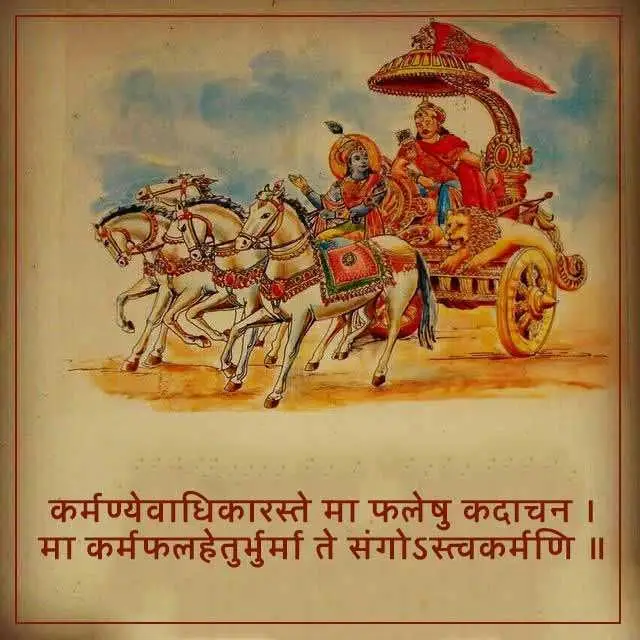Explore five more insightful shlokas from the Bhagavad Gita, complete with full verses, translations, and practical applications. Learn how these teachings can guide you toward inner peace, self-mastery, and spiritual growth in modern life.
5 Shlokas from the Bhagavad Gita with Full Verses and Practical Applications
The Bhagavad Gita offers timeless wisdom that provides guidance on living a life of purpose, peace, and balance. Each shloka contains profound insights that can be applied to daily life, helping individuals navigate challenges and find inner peace. Here are five more shlokas from the Bhagavad Gita, with translations and practical applications.
1. Shloka: Chapter 2, Verse 14
मात्रास्पर्शास्तु कौन्तेय शीतोष्णसुखदुःखदा:। आगमापायिनोऽनित्यास्तांस्तितिक्षस्व भारत॥
Translation: “O son of Kunti, the non-permanent appearance of happiness and distress, and their disappearance in due course, are like the appearance and disappearance of winter and summer seasons. They arise from sense perception, and one must learn to tolerate them without being disturbed.”
Application in Life:
This shloka teaches the impermanent nature of both happiness and sorrow. Just as the seasons change, emotions and life situations also fluctuate. Learning to endure temporary ups and downs without getting too attached to joy or despair helps in achieving emotional stability and peace.
Example:
When facing challenges in personal or professional life, remember that difficult times are temporary, and with patience and resilience, they will pass.
2. Shloka: Chapter 3, Verse 9
यज्ञार्थात्कर्मणोऽन्यत्र लोकोऽयं कर्मबन्धन:। तदर्थं कर्म कौन्तेय मुक्तसङ्ग: समाचर॥
Translation: “Work done as a sacrifice for the satisfaction of the Supreme must be performed, otherwise work binds one to this material world. Therefore, O son of Kunti, perform your prescribed duties for His satisfaction, and in that way, you will always remain free from bondage.”
Application in Life:
This shloka encourages selfless action and the importance of performing duties with a sense of devotion. It advises that we engage in our tasks without selfish motives, dedicating our work to a higher purpose, which in turn helps us avoid attachment and material entanglements.
Example:
In a professional context, instead of being driven purely by personal gains, aim to work for the greater good, contributing to society or a noble cause.
3. Shloka: Chapter 9, Verse 22
अनन्याश्चिन्तयन्तो मां ये जना: पर्युपासते। तेषां नित्याभियुक्तानां योगक्षेमं वहाम्यहम्॥
Translation: “To those who are constantly devoted to serving Me with love, I give what they lack and preserve what they have.”
Application in Life:
This shloka teaches that when a person dedicates themselves to selfless service and devotion, they need not worry about material needs. The universe provides for those who trust in a higher power, ensuring that they are cared for and protected.
Example:
When you focus on doing your best and serving others, life tends to support you in ways you may not expect. Trust the process and stay committed to your purpose, knowing that your needs will be met.
4. Shloka: Chapter 12, Verse 13-14
अद्वेष्टा सर्वभूतानां मैत्र: करुण एव च। निर्ममो निरहङ्कार: समदु:खसुख: क्षमी॥ सन्तुष्ट: सततं योगी यतात्मा दृढनिश्चय:। मय्यर्पितमनोबुद्धिर्यो मद्भक्त: स मे प्रिय:॥
Translation: “He who is free from malice toward all beings, who is friendly and compassionate, who is free from possessiveness and ego, who is balanced in joy and sorrow, forgiving, content, self-controlled, firm in resolve, and whose mind and intellect are fixed on Me, is dear to Me.”
Application in Life:
This shloka describes the qualities of a true devotee, emphasizing compassion, forgiveness, humility, and self-control. It teaches the value of living a balanced and compassionate life, free from hatred, jealousy, and attachment.
Example:
Cultivate kindness and empathy in relationships. Practice humility and learn to forgive others, which will lead to inner peace and harmony with those around you.
5. Shloka: Chapter 10, Verse 8
अहं सर्वस्य प्रभवो मत्त: सर्वं प्रवर्तते। इति मत्वा भजन्ते मां बुधा भावसमन्विता:॥
Translation: “I am the source of all spiritual and material worlds. Everything emanates from Me. The wise, who know this perfectly, engage in My devotional service and worship Me with all their hearts.”
Application in Life:
This shloka highlights the understanding of the divine as the source of all creation. Recognizing the divine presence in every aspect of life allows us to live with reverence, gratitude, and humility. It teaches that spiritual awareness brings peace and fulfillment.
Example:
Practice gratitude in daily life, acknowledging the beauty and abundance around you. By doing so, you will cultivate a sense of contentment and spiritual connection with the world.
Conclusion
These additional shlokas from the Bhagavad Gita provide practical wisdom for dealing with life’s challenges and living with purpose, compassion, and balance. By applying these teachings in our everyday lives, we can foster personal growth, emotional well-being, and spiritual fulfillment.

